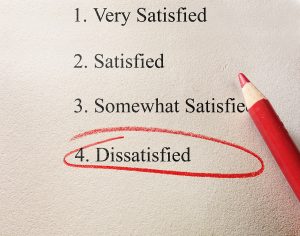Are You a Great Listener?
Have you ever run into someone who seems to an excellent listener? Did you think they must have been born with it?
Truth is we are born to be lousy listeners. What listening we typically pick up tends to be determined by our training and environment.
For example, ancient man learned to listen carefully for the sounds of predators that may threaten his clan but probably turned off the chatter of his wife and kids. HIs job was detecting and protecting against danger, so his on-the-job training was in listening for threats. The need for food drove him, so as part of his training he learned to listen for signs of potential food sources he could hunt down. Nothing else mattered and so he wasn’t trained to listen to it.
A Good Listener is NOT Natural
 At least, not naturally a good listener unless our instincts draw our focus to something. So we listen for signs of danger and we listen for opportunity to provide for ourselves. Everything else just whizzes by like an endless stream of 1s and 0s.
At least, not naturally a good listener unless our instincts draw our focus to something. So we listen for signs of danger and we listen for opportunity to provide for ourselves. Everything else just whizzes by like an endless stream of 1s and 0s.
Too Much Listening to Do
Our world has changed, however, and there is much more listening we MUST do and much more to which we MUST listen. The challenging of listening is multiplied exponentially for leaders.
For a leader to succeed he has to be aware of the thoughts of his team; each person’s mindset, attitude, aspirations, and ideas. Leaders must have an antenna constantly in tune with the broadcast of each and every employee or team member.
[tweetthis]Leaders must have antennae tuned to the broadcast of every team member. #listening[/tweetthis]
Good Listeners Enjoy a Wealth of Benefits:
Listeners Builds Trust
Trust is the foundation for any relationship or connection. Why? Because when we actively listen to others it means we are telling them that what they have to say matters – that THEY matter. We treat their ego with respect. Nothing shows love, respect, and esteem more than the intent listening ear. Listening connects with others by putting them first.
[tweetthis]Nothing shows love, respect, and esteem more than the intent listening ear. #listening[/tweetthis]
Ever have someone interrupt you in the middle of your thought? How did that make you feel? Interruptions are one of my pet peeves. To me, it signals that someone has no respect for what you have to say; that their thought is more important that yours. We trust people who respect us.
Good Listeners Gain Understanding
When we listen actively we increase our chances of grasping what someone is really trying to say. Far too often, we listen just enough to hear the trigger word that allows us to formulate and deliver a reaction, usually negative. You cannot truly understand when your own thoughts get in the way. Active listeners learn to put their own thoughts aside to consider others.
Effective Listeners Add to their Knowledge Bank
The purpose of communication in general is to gather or exchange information. Great leaders know that by being a good listener they get more information. Information is invaluable to a leader. Things you need to know such as how people are really feeling about things, their likes and dislikes, their dreams and desires, and what they value. The more you know, the better you can serve them.
Listeners Create Pause
The stillness of listening allows us to absorb and think through rather than react. Too many leaders tend towards react; thinking that as a leader they must be able to make immediate decisions and reactions. I have to temper myself constantly with this, being a highly interactive and fast-paced person. I remind myself to listen and not react. The stillness of listening and not reacting allows me be more deliberate, make better decisions, and respond instead of react.
Active Listeners Encourage Connection
People connect with people who can empathize and relate to them. They don’t want judgement and really don’t want answers. Philip Stanhope, once Earl of Chesterfield, said that “most people would rather you heard their story than granted their request.” When you listen to their story, value it and them, you open up the clear path to deeper connections. Until you connect, you cannot influence or lead.
True Listeners Discover Sparks of Creativity
Listening allows new thoughts and new ideas to enter our consciousness. I often find that something someone else says ignites an idea in my mind. From that also comes collaboration – working together to build and bring an idea to fruition. In addition, once you demonstrate your willingness and ability to listen, people will open up to you even more with the seeds for great ideas.
How to Start Listening Better
- MAKE THE SPEAKER THE PRIORITY
In that moment, the speaker needs ALL of your intention. Put the smartphone down, stop tapping the keys on the keyboard, don’t do anything else but focus on the speaker. - MAKE EYE CONTACT
Eye contact lets them know you are paying attention and that you value them. Here’s the caveat: don’t start them down. In general, make eye contact about 60-80% of the time. - ASK QUESTIONS
Don’t interrupt them, but ask questions that help seek clarity. Jim Rohn used to say one of the best phrases to use to spark conversation is simply to say “That’s interesting! Tell me more!“ - REPEAT THE MESSAGE
After they finish, repeat back them what you understood them to say. This allows them to either affirm or correct your understanding. This insures the message is fully received. Begin with “What I heard you say is…” and finish with “Is that correct?” Then let them confirm it or change it.








